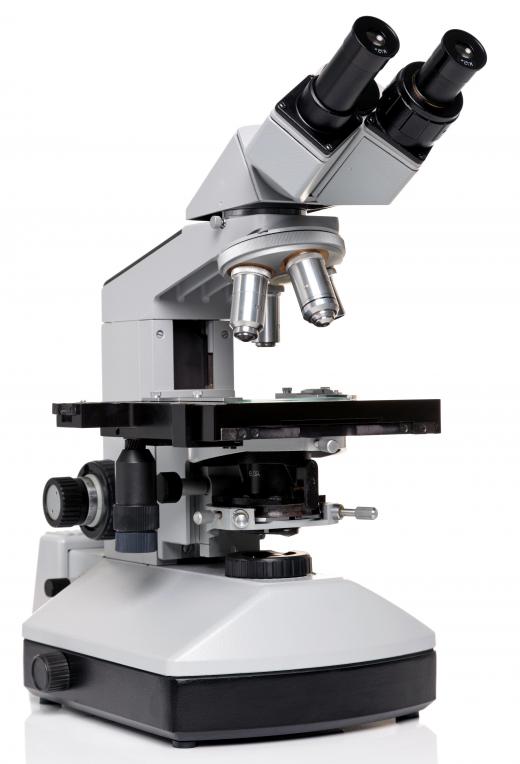What is a Binocular Microscope?
A binocular microscope is simply a microscope that uses two eyepieces instead of the traditional one used in many other types of microscopes. This binocular view offers a number of advantages and the costs are comparable to a single eyepiece instrument. The popularity of the binocular microscope has grown over the years and currently represents that vast majority of units sold.
The term binocular comes from two different words, with bi meaning two and ocular meaning related to vision. Together, these two words apply very well to a microscope with two eyepieces. Due to the fact the technology between a monocular microscope and binocular microscope is nearly identical, the only difference in cost between the two is simply the cost of additional materials.

Although some claim the binocular microscope gives a better sense of depth perception, that may not be the case. Rather, some types of microscopes may either have a goal of making an image three-dimensional or may focus on increasing resolution. This is the difference between a stereo microscope, which produces the 3D images, and a compound microscope. However, while a compound microscope does have the possibility of coming with only one eyepiece, a stereo microscope must be binocular.

There are three basic primary types of microscopes: the student, the benchtop and the research microscope. Any of these can be, and probably will be, a binocular microscope. The cheapest of these is the student microscope, which is so named because it is most commonly seen in the classroom. The price is the main reason for this. However, the microscope can also do most of the functions a student will need, making more expensive microscopes unneeded in most cases.
While the prices for a student microscope start at approximately $1,000 US Dollars (USD) and work their way up to approximately $2,000 USD, benchtop microscopes are more expensive yet. The cheapest may be found for approximately $4,000 USD. For those who are interested in a benchtop binocular microscope, there is one important thing to keep in mind. Unless you are an advanced molecular scientist, or studying to become one, most of the features of a benchtop system will go unused.
A binocular microscope can also be a research microscope. This type of microscope is the most advanced most people will ever see, much less ever use. These microscopes can weigh approximately 130 pounds (60 Kg) and can be quite large. The weight is taken up through the complex series of lenses and other ocular devices, as well as the electronics included inside the microscope.
AS FEATURED ON:
AS FEATURED ON:












Discussion Comments
@SZapper - I know exactly what you mean when you say it's uncomfortable to just keep one eye closed for awhile. I've used a monocular microscope before and I had the exact experience you describe.
I don't really see any reason to purchase a monocular microscope in this day and age though. If the cost is comparable, I think a binocular microscope would be the better choice.
I think a binocular microscope is probably a lot easier on the eyes than a monocular microscope. I say this because I majored in photography in college, and I used to always get a little bit of eye strain when I took picture.
I know this sounds weird, but having to scrunch one eye closed while looking through the lens gets really uncomfortable after awhile. I think it's probably a good thing for scientists everywhere that someone invented the binocular microscope.
My husband and I raise honeybees and have been interested in learning about the process of raising queen bees.
We didn't want to pay the full price for a new microscope, but wanted something that we could use to get a closer look at the bees.
We found a used binocular microscope in the classified ads. The price was reasonable and the microscope had hardly been used, so we went ahead and bought it.
I hadn't looked under a microscope since my days in high school. It works great for what we want to use it for, and I had forgotten how much more interesting things can look under a microscope than with the naked eye.
Post your comments